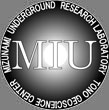
TOP
| Phase III (Operation Phase / In-situ investigations and experiments at the depth) |
In Phase III, the investigations, analyses and evaluation methods and the engineering techniques will be applied at both the -500m(stage) and the Main Stages to test and assess their applicability in different geological environments. Extension of the research galleries excavated in Phase II could disturb the geological environment by excavation induced damage, stress redistribution/ concentration and changes to the flow system. These disturbances and associated phenomena(EDZ development) observed around the galleries will be subject to detailed study. Especially in the second half of Phase III, new horizontal galleries will be excavated to examine changes in rock mechanical properties related to their excavation. The details of the investigations will be planned taking (the results of investigations carried out in the previous Phases) into account.
Regarding engineering technology, the effectiveness of the technology for long-term maintenance of shaft and gallery stability and assuring safety within the gallery will be demonstrated through operational maintenance and management of the research galleries. At the same time, engineering technology regarding restoration or reversal and mitigating of the excavation effect on the geological environment will be developed, if necessary.
The investigation plan and research acivities for each stage will be examined and revised on the basis of the actual conditions encountered.
Phase III goals
- Revise and improve the models of the geological environment using the results of underground investigations and determine any change in the geological environment in response to research gallery extension
- Evaluate the effectiveness of engineering techniques used for deep underground
The following investigations and others are planned.
- Geological mapping of the middle and main drifts.
- Hydraulic interference test focused on a single fracture and a fracture network.
- Redox experiment in the boreholes drilled from the drift.
- Geophysical investigations, AE measurements, etc. in the drift for evaluating the EDZ.
- Tracer experiments focused on the single fracture and fracture zones.
- Hydraulic pressure and hydrochemical monitoring in the boreholes drilled from the surface around the shaft.